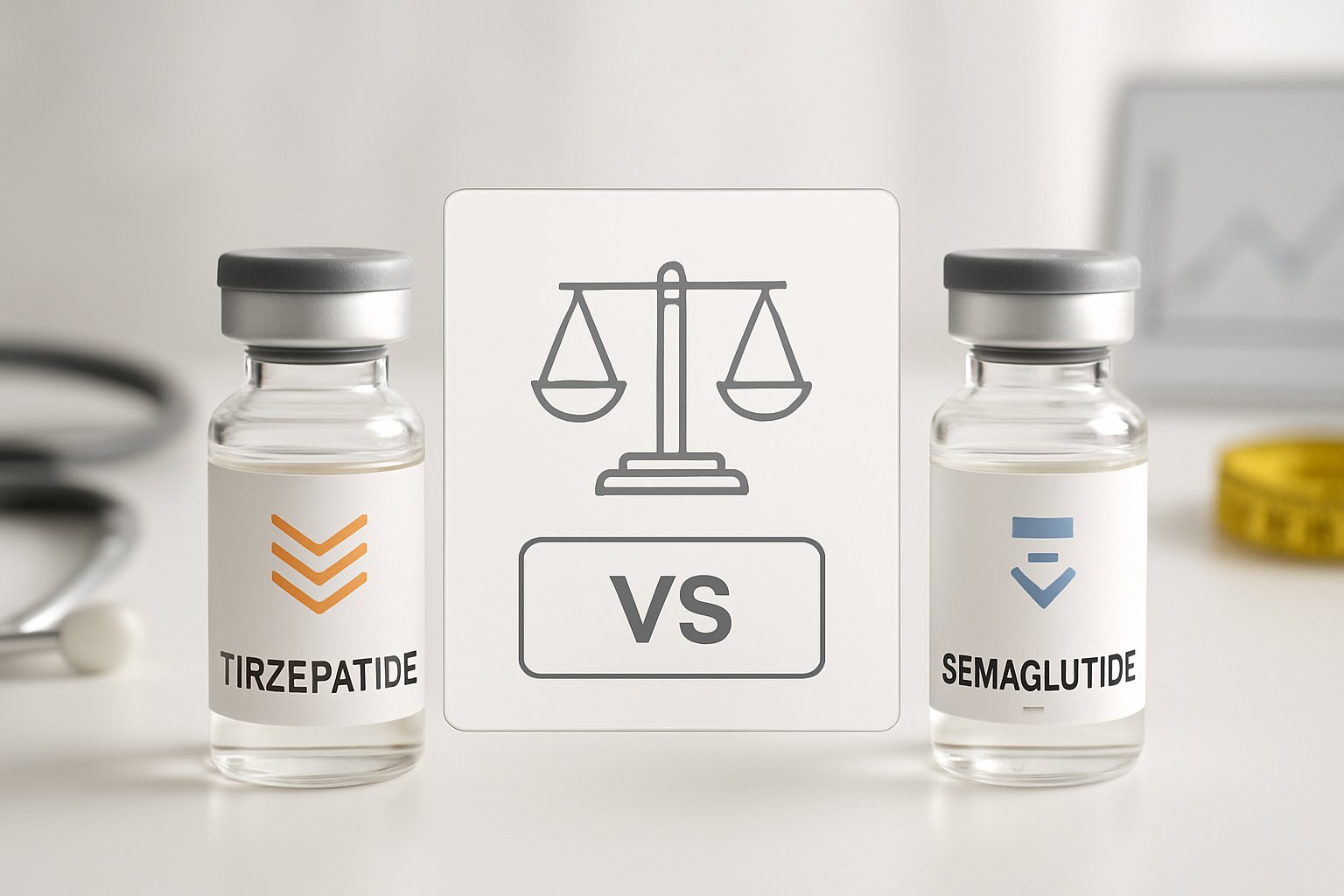Two popular weight loss medications have changed how doctors treat obesity: semaglutide and tirzepatide. Both drugs help people lose weight by affecting hormones that control hunger and blood sugar. Many patients and doctors want to know which one works better.
Research shows that tirzepatide may be more effective than semaglutide for weight loss, with studies finding an average weight loss of 17.8% compared to 12.4% with semaglutide. However, the choice between these medications depends on many factors beyond just effectiveness. Each drug has different dosing schedules, side effects, and approval guidelines.
Understanding how these medications work and differ can help patients have better conversations with their doctors. Both tirzepatide and semaglutide are FDA-approved drugs[1] that require weekly injections and work best when combined with diet and exercise changes.
Key Takeaways
- Tirzepatide shows greater weight loss results than semaglutide in clinical studies
- Both medications have similar side effects but work through different hormone pathways
- The best choice depends on individual health needs, age, and medical history
Head-to-Head Comparison of Tirzepatide and Semaglutide

The SURMOUNT-5 clinical trial[2] provided the first direct comparison between tirzepatide and semaglutide for weight loss in people without diabetes. Tirzepatide showed superior results with 20.2% weight loss compared to semaglutide’s 13.7% weight loss after 72 weeks.
Key Findings From Clinical Trials
The SURMOUNT-5 randomized controlled trial involved 751 participants with obesity but without type 2 diabetes. This head-to-head trial ran for 72 weeks and compared maximum tolerated doses of both medications.
Participants received either tirzepatide (10 mg or 15 mg) or semaglutide (1.7 mg or 2.4 mg) through weekly injections. The study used an open-label design where both participants and researchers knew which medication was being used.
Weight Loss Milestones Achieved:
- 10% or more weight loss: More tirzepatide users reached this goal
- 15% or more weight loss: Tirzepatide group showed higher success rates
- 20% or more weight loss: Greater proportion achieved with tirzepatide
- 25% or more weight loss: Tirzepatide nearly doubled the success rate
The difference between tirzepatide and semaglutide[3] was 6.5 percentage points in total weight loss.
Average Weight Loss Results
Tirzepatide demonstrated significantly better weight loss outcomes in this head-to-head trial. The mean weight reduction was 20.2% for tirzepatide compared to 13.7% for semaglutide after 72 weeks.
These results align with earlier research. A 2023 review found tirzepatide resulted in 17.8% weight loss[1] compared to 12.4% with semaglutide across multiple studies.
The statistical analysis showed the difference was highly significant (P<0.001). This means the superior performance of tirzepatide was not due to chance.
Both medications work as GLP-1 receptor agonists, but tirzepatide also targets GIP receptors. This dual action may explain its enhanced weight loss effects compared to semaglutide alone.
Waist Circumference and Body Composition Changes
Tirzepatide produced greater reductions in waist circumference than semaglutide. The mean change in waist circumference was 18.4 cm[2] with tirzepatide versus 13.0 cm with semaglutide.
This 5.4 cm difference was statistically significant (P<0.001). Waist circumference changes indicate improvements in abdominal fat, which is linked to metabolic health risks.
The waist circumference results support the overall weight loss findings. Participants using tirzepatide experienced more substantial changes in body composition beyond just total weight reduction.
These measurements suggest tirzepatide may be more effective at targeting visceral fat. Visceral fat reduction is important for improving metabolic health and reducing disease risk factors.
How Tirzepatide and Semaglutide Work

Both drugs target hormone pathways that control blood sugar and appetite, but tirzepatide activates two receptors while semaglutide works on just one. This difference affects how strongly each medication impacts weight loss and metabolic function.
GLP-1 and GIP Pathways
Semaglutide is a GLP-1 receptor agonist that mimics a hormone called GLP-1. This hormone gets released from the intestines after eating and helps control blood sugar levels.
GLP-1 receptor agonists work by binding to GLP-1 receptors throughout the body. These receptors are found in the pancreas, brain, stomach, and other organs.
Tirzepatide takes a different approach. It activates both GLP-1 receptors and GIP receptors. GIP stands for glucose-dependent insulinotropic polypeptide.
The GIP receptor controls how the body processes fat and sugar. When both pathways work together, they create stronger effects on metabolism than GLP-1 alone.
Both tirzepatide and semaglutide are GLP-1 agonist prescription medicines[4] used with diet and exercise. The dual action of tirzepatide makes it work differently than single-pathway medications.
Mechanism of Action in Weight Loss
These medications cause weight loss through several body processes. They slow down how fast food moves through the digestive system.
GLP-1 receptor agonist medications increase insulin production when blood sugar rises. They also reduce glucagon, a hormone that raises blood sugar levels.
The drugs work on brain areas that control hunger and food cravings. This helps people feel full with smaller meals and reduces between-meal snacking.
Tirzepatide’s dual receptor activation affects fat storage and burning. The GIP pathway helps the body use stored fat for energy more effectively.
Blood sugar control also supports weight loss. When glucose levels stay stable, the body stores less fat and has fewer intense hunger signals.
Impact on Hunger, Appetite, and Gastric Emptying
Gastric emptying slows significantly with both medications. Food stays in the stomach longer, creating lasting fullness after meals.
The drugs reduce appetite by affecting brain signals. They work on areas that control food reward and craving responses.
People taking these medications often report feeling satisfied with smaller portions. The delayed gastric emptying means they stay full for several hours after eating.
Nausea can occur as a side effect of slower digestion. This typically improves as the body adjusts to the medication over several weeks.
Tirzepatide and semaglutide work in slightly different ways[5] to control appetite and digestion. The stronger dual-pathway action of tirzepatide often leads to greater appetite suppression than semaglutide alone.
Approved Uses and Indications

Both semaglutide and tirzepatide have received FDA approval for treating type 2 diabetes and chronic weight management in adults. Zepbound is also approved to treat obstructive sleep apnea[1], expanding tirzepatide’s therapeutic applications beyond weight and blood sugar control.
Weight Loss in Obesity and Overweight
The FDA has approved specific formulations of both medications for chronic weight management. Wegovy (semaglutide) and Zepbound (tirzepatide) are designated for weight loss treatment.
These medications are approved for adults with a Body Mass Index (BMI) of 30 or higher. They are also approved for individuals with a BMI of 27 or higher who have at least one weight-related health condition.
Weight-related conditions include high blood pressure, high cholesterol, or type 2 diabetes. The medications must be combined with a reduced-calorie diet and increased physical activity.
Wegovy is approved for weight loss in children 12 years and older[4]. Zepbound does not have pediatric approval for weight management at this time.
Both medications require weekly injections under the skin. Patients typically start with lower doses that gradually increase over several months.
Type 2 Diabetes Management
Semaglutide is available as Ozempic for type 2 diabetes treatment. Tirzepatide is marketed as Mounjaro for the same indication.
Both medications help lower blood sugar levels in adults with type 2 diabetes. They work by increasing insulin production when blood sugar levels are elevated.
The medications also slow down stomach emptying, which helps control blood sugar spikes after meals. This mechanism contributes to better overall glucose control throughout the day.
A 2021 study found tirzepatide was more effective than semaglutide in reducing blood sugar levels[1] in people with type 2 diabetes after 40 weeks of treatment.
Patients with type 1 diabetes should not use either medication. These drugs are specifically designed for type 2 diabetes management only.
Healthcare providers may prescribe these medications alongside other diabetes treatments. The combination approach helps achieve better blood sugar control for many patients.
Obesity-Related Comorbidities
Zepbound recently received FDA approval for treating obstructive sleep apnea[1] in adults with obesity. This represents the first medication approved specifically for sleep apnea treatment.
Weight loss from these medications can improve various cardiovascular risk factors. Patients often see improvements in blood pressure, cholesterol levels, and inflammation markers.
The medications may help reduce the risk of heart disease and stroke through weight reduction. However, they are not specifically approved for cardiovascular protection as a primary indication.
Chronic kidney disease patients may benefit from the blood sugar control these medications provide. Weight loss can also reduce stress on the kidneys over time.
Both medications address multiple aspects of metabolic health simultaneously. The weight loss achieved often leads to improvements in obesity-related conditions without separate treatments.
Healthcare providers consider the full range of a patient’s health conditions when prescribing these medications. The comprehensive benefits often make them valuable for patients with multiple weight-related health issues.
Side Effects and Safety Profile

Both medications share similar side effect profiles due to their related mechanisms of action, though studies show tirzepatide may cause more severe stomach problems[4] at higher doses. The most common issues affect the digestive system and typically improve over time.
Common Side Effects
Nausea ranks as the most frequent side effect for both drugs. It affects over 20% of patients taking semaglutide and up to 30% of those using tirzepatide.
Fatigue commonly occurs during the first few weeks of treatment. Many patients report feeling tired as their body adjusts to the medication.
Dizziness affects roughly 10-15% of users. This often happens when standing up quickly or during dose increases.
Injection site reactions include redness, swelling, or mild pain at the injection area. These reactions usually resolve within a few days.
Hair loss has been reported by some patients, though it’s less common than other side effects. This typically occurs after several months of treatment and may be related to rapid weight loss rather than the medication itself.
Gastrointestinal Symptoms
Stomach side effects occur in over 50% of patients[4] taking either medication. These symptoms usually start when beginning treatment or increasing doses.
Vomiting happens more often with tirzepatide, especially at the 15mg dose. About 15-20% of patients experience this side effect during the first month.
Diarrhea affects approximately 20-25% of users. It tends to be more severe with higher doses of both medications.
Constipation occurs in about 15% of patients. This can alternate with diarrhea as the digestive system adjusts.
Abdominal pain and bloating affect roughly 10-15% of users. These symptoms often improve as the stomach adapts to slower digestion.
Indigestion commonly occurs due to delayed stomach emptying. Eating smaller meals helps reduce this problem.
Other Reported Adverse Reactions
Serious side effects remain rare but require medical attention. Pancreatitis occurs in less than 1% of patients but needs immediate treatment.
Gallbladder problems can develop during rapid weight loss. Symptoms include severe abdominal pain, especially after eating fatty foods.
Low blood sugar rarely happens unless combined with other diabetes medications. Patients taking insulin or sulfonylureas face higher risk.
About 4% to 8% of patients stop treatment[4] due to side effects. Most discontinue because of persistent nausea, vomiting, or diarrhea.
Kidney problems can occur if severe vomiting or diarrhea leads to dehydration. Staying hydrated helps prevent this complication.
Thyroid concerns exist based on animal studies, though human cases remain extremely rare. Patients with personal or family history of thyroid cancer should discuss risks with their doctor.
Factors to Consider When Choosing a Medication

The choice between semaglutide and tirzepatide depends on several key factors including out-of-pocket costs, insurance approval, how often patients want to inject the medication, and guidance from medical professionals.
Cost and Insurance Coverage
Both medications carry high list prices that can reach over $1,000 per month without insurance coverage. Semaglutide brands like Wegovy and Ozempic may have broader insurance coverage since they entered the market first.
Tirzepatide options from Lilly, including Mounjaro and Zepbound, are newer and may face more insurance restrictions. Some plans require prior authorization or step therapy protocols.
Insurance approval factors:
- Medical necessity documentation
- BMI requirements (typically 30+ or 27+ with health conditions)
- Previous weight loss attempt records
- Healthcare provider justification
Patient assistance programs exist for both medications. NovoCare offers support for semaglutide products, while Lilly provides savings programs for tirzepatide users who qualify based on income and insurance status.
Administration and Dosing Differences
Both medications require weekly injections under the skin. Tirzepatide typically starts at 2.5 mg and increases gradually to a maximum of 15 mg. Semaglutide begins at 0.25 mg and can reach 2.4 mg for weight loss.
The injection pens differ slightly in design and needle size. Some patients find one easier to handle than the other. Both can cause injection site reactions like redness, swelling, or mild pain.
Dosing schedules:
- Both inject once weekly on the same day
- Gradual dose increases over several months
- Injection sites should be rotated between thigh, abdomen, and upper arm
Patients who miss doses need specific guidance on timing. Healthcare providers typically recommend injecting as soon as remembered if within 4 days of the scheduled dose.
Role of Healthcare Providers
Healthcare providers evaluate multiple factors before prescribing either medication. They assess medical history, current medications, kidney function, and potential drug interactions.
Regular monitoring appointments track weight loss progress and side effects. Providers adjust doses based on tolerance and effectiveness. They also provide guidance on managing common side effects like nausea or digestive issues.
Provider responsibilities include:
- Initial medical clearance and screening
- Dose titration based on patient response
- Monitoring for serious side effects
- Coordinating with insurance for approvals
Some providers have preferences based on their clinical experience with specific medications. They may recommend one over the other based on individual patient factors like diabetes status, previous medication responses, or specific health goals.
Lifestyle Integration and Long-Term Outlook

Both semaglutide and tirzepatide require lasting changes to diet and exercise habits for best results. Regular check-ins with healthcare providers help track progress and adjust treatment plans as needed.
Diet and Exercise Requirements
Semaglutide works best when paired with a reduced-calorie diet. Most doctors suggest cutting 500-750 calories per day from normal intake.
Patients should focus on protein-rich foods and limit processed items. The drug helps reduce appetite, making portion control easier.
Tirzepatide also requires dietary changes for maximum weight loss. Studies show better results when combined with lifestyle coaching.
Both drugs need regular physical activity. Doctors typically recommend:
- 150 minutes of moderate exercise per week
- Strength training twice weekly
- Daily walking or movement
Exercise helps maintain muscle mass during weight loss. It also improves the drugs’ effectiveness over time.
Ongoing Monitoring and Support
Healthcare providers schedule regular visits every 1-3 months during treatment. These appointments track weight loss progress and check for side effects.
Blood tests monitor blood sugar levels and kidney function. Doctors adjust doses based on how well patients respond to treatment.
Key monitoring includes:
- Monthly weight checks
- Blood pressure measurements
- Diabetes screening tests
- Liver function tests
Many patients benefit from working with dietitians or weight loss counselors. Support groups also help people stick to their new habits.
Insurance coverage varies for both drugs. Patients may need prior approval from their healthcare provider.
Potential for Weight Regain
Stopping either drug often leads to weight regain within 6-12 months. Studies show patients regain 60-70% of lost weight after discontinuing treatment.
Tirzepatide may have slightly better long-term results. Some patients maintain more weight loss after stopping compared to semaglutide users.
Both drugs work best as long-term treatments rather than short-term solutions. Patients who continue taking the medication maintain their weight loss better.
Lifestyle changes learned during treatment help reduce weight regain. Regular exercise and healthy eating habits remain important even after stopping the drugs.
Some people may need to stay on these medications indefinitely to maintain their weight loss goals.
Frequently Asked Questions

Patients considering these weight loss medications often have questions about their effectiveness, dosing, side effects, and costs. Research shows tirzepatide may produce greater weight loss than semaglutide, while both medications share similar side effect profiles and require gradual dose increases.
What are the comparative effectiveness of Semaglutide and Tirzepatide in promoting weight loss?
Research suggests tirzepatide may be more effective than semaglutide for weight loss[1]. A 2023 review found tirzepatide led to 17.8% total body weight loss compared to 12.4% with semaglutide.
A 2024 study showed people with obesity had greater weight loss with tirzepatide than semaglutide. However, the doses used in these studies were not equal, which could affect the results.
Both medications can be effective tools for weight loss, but clinical trial data suggests that Zepbound (tirzepatide) may lead to more weight loss than Wegovy (semaglutide)[5]. More head-to-head trials are needed to confirm these findings.
Can you provide a comparison of the recommended dosages for Semaglutide and Tirzepatide when used for weight management?
Both drugs are injected under the skin once per week. The doses must be increased slowly over 20 weeks, with increases every four weeks.
Tirzepatide starts at 2.5 mg per week for four weeks. The dose can increase by 2.5 mg every four weeks up to a maximum of 15 mg per week.
Semaglutide starts at 0.25 mg per week for four weeks. The dose increases every four weeks to 0.5, 1.0, 1.7, or 2.4 mg, with a maximum dose of 2.4 mg once weekly.
What side effects have been observed in patients using Semaglutide compared to those using Tirzepatide?
Semaglutide and tirzepatide have nearly similar side effects[1]. Common side effects include nausea, vomiting, diarrhea, constipation, and stomach pain.
Other shared side effects include fatigue, heartburn, decreased appetite, and stomach upset. These side effects are usually mild and often go away on their own.
Both drugs can cause serious side effects like kidney problems, gallbladder disease, and pancreas inflammation. They also carry warnings about thyroid tumors, including cancer.
How does the cost of treatment with Semaglutide compare to that of Tirzepatide for patients?
Semaglutide costs more than tirzepatide. However, actual costs depend on whether insurance covers the treatment.
Both drugs cost between $5,000 and $10,000 per year in the United States. Manufacturer copay cards may help reduce costs for some patients.
A 2023 study suggested tirzepatide provides better cost value than semaglutide. This is partly because tirzepatide may be more effective for weight loss.
Under what circumstances should a patient consider switching from Semaglutide to Tirzepatide?
Switching between these medications is not unusual for weight loss treatment. Patients need to consult their healthcare provider before making any changes.
A person might switch if they are not losing enough weight with their current medication. They might also switch if they experience side effects that are hard to manage.
Some people may switch based on cost considerations or insurance coverage changes. Age restrictions may also play a role, as tirzepatide is not approved for children under 18.
Are there any significant differences in the long-term outcomes of using Semaglutide versus Tirzepatide for weight reduction?
Limited long-term data exists for both medications since they are relatively new for weight loss treatment. Semaglutide was approved for weight management in 2021, while tirzepatide was approved in 2023.
Current studies suggest tirzepatide may maintain better weight loss over time. However, more research is needed to confirm long-term differences between the two drugs.
Both medications require continued use to maintain weight loss benefits. Stopping either medication typically leads to weight regain over time.
References
- Both tirzepatide and semaglutide are FDA-approved drugs. https://www.verywellhealth.com/tirzepatide-vs-semaglutide-8690775 Accessed October 21, 2025
- Just a moment.... https://www.nejm.org/doi/full/10.1056/NEJMoa2416394 Accessed October 21, 2025
- Tirzepatide vs semaglutide: A head-to-head comparison for management of obesity. https://www.healthed.com.au/clinical_articles/tirzepatide-vs-semaglutide-a-head-to-head-comparison-for-management-of-obesity/ Accessed October 21, 2025
- Tirzepatide vs semaglutide: How do they compare?. https://www.drugs.com/medical-answers/tirzepatide-semaglutide-how-compare-3576410/ Accessed October 21, 2025
- Tirzepatide vs. Semaglutide for Weight Loss. https://ro.co/weight-loss/tirzepatide-vs-semaglutide/ Accessed October 21, 2025
